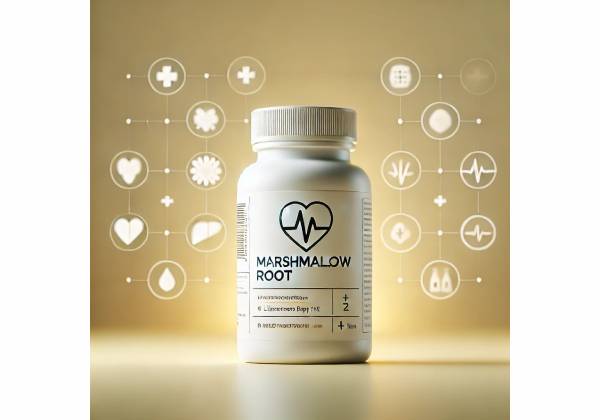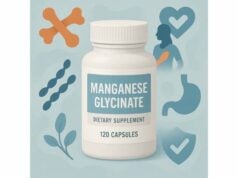
Marshmallow root (Althaea officinalis) is a classic soothing herb with a long record of use for irritated throats, dry coughs, and mild digestive discomfort. Its strength comes from mucilage—gel-like polysaccharides that form a thin, protective coating on tender mucous membranes. Many people reach for it as tea, syrup, or lozenges when the air is dry or a cold lingers. Beyond comfort, modern lab and clinical studies suggest gentle anti-inflammatory and antioxidant activity that may help calm irritated tissues. The plant is flexible, too: you can prepare a cold-water macerate (ideal for preserving mucilage), choose a standardized liquid extract, or keep sugar-free lozenges on hand. Marshmallow is usually well tolerated when taken as directed. Still, it’s not a cure-all: spacing it away from other medicines matters because its mucilage can delay drug absorption, and persistent or severe symptoms deserve medical care. This guide offers straightforward, evidence-informed advice on how marshmallow root works, who benefits most, how to use it correctly, and what safety steps to keep front and center.
Essential Insights
- Eases dry cough and sore throat by coating and hydrating irritated mucous membranes.
- May relieve mild gastrointestinal irritation (e.g., heartburn-like discomfort) through demulcent action.
- Typical adult range: 2–5 g dried root (cold macerate) up to 3 times daily; maximum 15 g dried root per day.
- Separate from other medicines by 30–60 minutes to avoid delayed absorption.
- Avoid if you’re allergic to Malvaceae plants; use caution in pregnancy and breastfeeding due to limited data.
Table of Contents
- What is marshmallow root?
- What benefits are backed by evidence?
- How to use it right (forms and preparation)
- How much marshmallow root per day?
- Safety, interactions, and who should avoid it
- Quality, standardization, and buying tips
What is marshmallow root?
Marshmallow root comes from Althaea officinalis, a soft-stemmed perennial in the mallow family (Malvaceae). The part used medicinally is the peeled or unpeeled root, harvested from plants at least two years old and dried. While the name evokes the confection, modern marshmallows no longer contain this herb; the link is historical, not functional.
The root is rich in mucilage—water-loving polysaccharides that swell into a viscous gel when hydrated. This mucilage forms a breathable, protective layer over inflamed mucosa in the mouth, throat, and upper digestive tract. Think of it as a temporary, edible “comfort coat”: it reduces friction, locks in moisture, and helps shield irritated tissue from mechanical, thermal, and acid-related stress. In vitro research adds plausible mechanisms beyond coating: marshmallow root extracts have shown anti-inflammatory effects (e.g., dampening cytokines like TNF-α and IL-6), antioxidant actions against reactive oxygen species, and modest antimicrobial properties in selected models. These findings help explain why people often report quick soothing for scratchy throats and a gentler cough reflex shortly after dosing.
Two traditional indications match this pharmacology well: (1) oral or pharyngeal irritation with associated dry, tickly cough, and (2) mild gastrointestinal discomfort (such as heartburn-like irritation). The herb’s benefits feel local and surface-level—perfect for dryness, scratchiness, and mild inflammation. For deeper, systemic conditions (pneumonia, peptic ulcer disease, severe reflux, persistent cough with shortness of breath or fever), marshmallow is not sufficient on its own and medical evaluation is warranted.
Preparation matters. Hot water can degrade mucilage; that’s why cold-water maceration is preferred when you want maximum “slippery” demulcent action. Syrups, lozenges, and standardized liquid or dry extracts are convenient alternatives for those who prefer ready-to-use formats. Each form can deliver the core benefit: lining and hydrating irritated tissue so it can quiet down and heal.
Finally, marshmallow root is generally well tolerated at typical doses. Its most notable practical caveat is spacing: the mucilage layer can slow the absorption of nearby medicines, so it should be taken at least 30–60 minutes apart from other oral drugs. That simple timing step preserves both marshmallow’s benefits and your medication’s effectiveness.
What benefits are backed by evidence?
Dry, irritating cough and sore throat. The combination of bioadhesive mucilage and anti-inflammatory activity underpins marshmallow’s role for scratchy throats and tickly, nonproductive coughs. People often notice relief within minutes as the coating effect reduces friction and hydration improves comfort. Clinical and real-world reports with water extracts and syrups suggest reductions in throat irritation and cough frequency, along with very good tolerability. While many cough formulas blend marshmallow with other botanicals (ivy, thyme, ginger), extracts of marshmallow root are used on their own, especially in syrups and lozenges. Lab studies provide plausible support: root extracts have dampened pro-inflammatory cytokines and oxidative stress markers in human cell models, and polysaccharides appear to adhere to epithelial surfaces, creating a protective film that calms the cough reflex.
Oral mucositis and mouth soreness. Small randomized, controlled trials in oncology settings have explored marshmallow root as a component in mouthwashes for chemotherapy-induced stomatitis. In these studies, solutions containing the hydroalcoholic root extract used multiple times daily were associated with improvements in stomatitis scores and patient comfort compared with routine mouth rinses alone. The demulcent film likely cushions ulcerated mucosa from irritation, while anti-inflammatory effects may contribute to symptom relief. These are not large, multicenter trials, and protocols vary, but taken together they reinforce marshmallow’s topical soothing role for inflamed oral tissues.
Mild gastrointestinal discomfort. The same mucilage that soothes the throat can help the upper GI tract. By forming a gel-like barrier on irritated esophageal and gastric surfaces, marshmallow may reduce the abrasive contact of acid and food particles and support hydration of the mucosa. People often use it for transient, heartburn-like irritation or after dietary indiscretions. The demulcent action is surface-level and symptomatic; it does not replace evaluation for persistent reflux, dysphagia, bleeding, or unexplained weight loss. Cold macerates are particularly useful here because they deliver a high mucilage load without heat degradation.
Skin comfort (topical use). Traditional use includes creams or ointments with powdered root for minor skin irritation. The same film-forming carbohydrates that adhere in the mouth can provide a softening, emollient effect on dry or irritated skin. Contemporary topical studies are limited and heterogeneous, yet the rationale remains sound for mild, noninfected irritation when barrier support and hydration are the goals.
What not to expect. Marshmallow will not meaningfully suppress a wet, productive cough (where expectoration is helpful) or treat underlying infections on its own. It is not a substitute for acid-suppressive therapy when that’s clearly indicated, nor for inhalers or antibiotics when prescribed. Instead, its niche is targeted comfort: quelling irritation so tissues can recover while other treatments address root causes if present.
Who seems to benefit most? People with a dry, tickly cough that worsens with speaking; those with throat scratchiness from viral upper respiratory infections or dry indoor air; and individuals with mild, intermittent reflux-like irritation after meals often report the most noticeable improvements. Those with persistent, severe, or complex symptoms should use marshmallow, if at all, as a supportive measure while working with a clinician.
How to use it right (forms and preparation)
You can choose among several formats. Aim for the form you’ll actually use consistently, and match it to your main symptom.
1) Cold macerate (maximizes mucilage).
This is the most “classic” preparation for demulcent goals.
- Place 2–5 g of finely cut, dried marshmallow root in a jar (about 1–2 teaspoons by weight; a scale is best).
- Add 150–250 ml cold or room-temperature water.
- Stir or shake, then cover and steep for 30–90 minutes, agitating occasionally to help the mucilage dissolve.
- Strain through a fine mesh or cloth. Drink slowly to let the liquid dwell on the throat and esophagus.
- Prepare fresh each time; the gel can spoil quickly at room temperature.
2) Syrups.
Syrups are convenient for throat and cough support. Some products are simple macerate-based syrups; others include standardized aqueous extracts. Adults commonly take 10–15 ml per dose, several times daily, depending on the product instructions. If you monitor blood sugar or prefer to avoid sucrose, choose a sugar-free formula or switch to lozenges or alcohol-free liquids.
3) Lozenges and pastilles.
Slowly dissolving lozenges prolong mucosal contact time, helpful when speaking or singing. Typical use is 1 lozenge every 2–3 hours as needed, within the manufacturer’s daily limit. Look for products that specify marshmallow root or its extract (rather than “mallow flavor”).
4) Liquid extracts (tinctures and fluid extracts).
A common traditional strength is 1:1 (g/ml) in 25% ethanol. Adults often use 2–5 ml up to three times daily diluted in water. Alcohol-free glycerites and standardized aqueous extracts exist and may be preferable for children or those avoiding alcohol.
5) Dry extracts (capsules or powders).
Dry extracts are labeled with a drug-extract ratio (DER), often 3–9:1 with water as the solvent. The key is equivalence to the dried root: products should state how many milligrams of capsule correspond to how many grams of root. Doses usually mirror the dried-root daily maximum (i.e., up to the equivalent of 15 g/day), divided.
Timing with other medicines.
Because marshmallow’s mucilage can delay drug absorption, take it at least 30–60 minutes apart from oral medications and supplements (before or after). For once-daily medicines with narrow therapeutic windows, keep the separation consistent day to day.
Duration and when to seek care.
For cough and throat irritation, if symptoms persist beyond about a week—or if you develop fever, shortness of breath, chest pain, or pus-colored sputum—seek medical attention. For GI discomfort, arrange evaluation if symptoms last beyond two weeks or include alarm signs (trouble swallowing, bleeding, unexplained weight loss, anemia).
Practical tips.
- Sip slowly rather than gulping; prolonged contact improves comfort.
- For nighttime throat dryness, a syrup or lozenge close to bedtime may help—still respect the medication spacing rule.
- Store dried root in an airtight container away from humidity.
- If you’re sensitive to added flavors or sweeteners, choose simple formulas with minimal excipients.
How much marshmallow root per day?
Below are commonly used ranges that align with traditional monographs and modern product labeling. Always follow your specific product’s directions, which should map to these equivalences.
Dried root (tea/macerate)
- Adults and older adults: 2–5 g per serving as a cold macerate, up to three times daily.
- Maximum daily total of dried root: 15 g.
- For throat/cough support, smaller, more frequent servings (e.g., 0.5–3 g per dose in ~150 ml water several times daily) are typical.
- For mild GI discomfort, 2–5 g per dose three times daily works well for many.
Liquid extract (1:1 in 25% ethanol)
- Adults: 2–5 ml per dose, three times daily (total 6–15 ml/day).
- Not generally recommended for children unless directed by a clinician; consider alcohol-free alternatives.
Aqueous liquid extract (high-dilution macerates; syrup bases)
- Adults: product-specific, often expressed in grams of extract or milliliters of syrup per dose. A common adult single dose of syrup is 10–15 ml, taken 3–5 times daily.
- These liquids may show dosing ranges equivalent to grams of dried root—check the label for “corresponds to X g herbal substance.”
Dry extract (DER 3–9:1, water)
- Adults: per-dose amounts corresponding to 0.5–3 g of dried root, taken several times daily, staying within the maximum daily equivalent of 15 g dried root.
Pediatric considerations (for throat/cough).
- 3–5 years: 0.5–1 g dried root per dose as a macerate, about three times daily (daily total 1.5–3 g).
- 6–11 years: 0.5–1.5 g dried root per dose as a macerate, about three times daily (daily total 1.5–4.5 g).
- Solid dosage forms (e.g., capsules) are generally not recommended under 6 years because of swallowing risks.
- Under 3 years: do not use for cough or throat irritation unless a pediatric clinician advises otherwise.
How long to use it.
- Cough/throat: if not improving after ~7 days of correct use, or if symptoms worsen, consult a clinician.
- GI discomfort: reassess with a clinician if symptoms persist beyond ~14 days.
Real-world dosing examples.
- Dry cough with scratchy throat: 1 lozenge every 2–3 hours (within label limits) during the day; 10–15 ml syrup at bedtime; optional 2–3 g cold macerate mid-afternoon.
- Meal-related heartburn-like irritation: 3–5 g cold macerate 30–60 minutes after meals, separated from medications; discontinue and seek evaluation if symptoms persist.
Why these ranges work.
They reflect equivalence to the dried root—the anchor for traditional use and modern monographs. Whether you take a lozenge, syrup, or extract, the daily exposure should roughly match what you’d get from up to 15 g of root spread over the day, tailored to symptom intensity and sensitivity.
Safety, interactions, and who should avoid it
Overall tolerability. Marshmallow root has a low side-effect profile when used as directed. Reported adverse events are uncommon and typically mild (e.g., occasional gastrointestinal fullness from the gel). Post-marketing and observational data with syrups in children and adults show very good tolerability under recommended conditions.
Medication timing matters. The most practical interaction concern is delayed absorption of other oral medicines and supplements due to mucilage coating the gut lining. As a precaution, take marshmallow at least 30–60 minutes before or after other oral products. This applies to prescription drugs, over-the-counter medicines, and vitamins.
When to get medical care urgently.
- Cough with shortness of breath, chest pain, wheezing, or high fever.
- Cough lasting more than a week or producing thick, green/yellow, or blood-streaked sputum.
- Trouble swallowing, persistent hoarseness, or voice changes.
- GI symptoms with red flags: progressive difficulty swallowing, bleeding (black stools or vomiting blood), unintentional weight loss, persistent vomiting, or anemia.
Specific cautions.
- Pregnancy and breastfeeding: Human data are limited; routine use is not recommended without individualized clinical guidance.
- Children: Avoid for cough/throat irritation under 3 years unless advised by a pediatric clinician; use age-appropriate liquid forms and avoid solids under 6 years.
- Allergy: Do not use if you’re allergic to marshmallow or other Malvaceae plants. Discontinue if rash, itching, or swelling occurs.
- Diabetes or carbohydrate-restricted diets: Many syrups contain sucrose. Choose sugar-free formulas or non-syrup forms (e.g., macerate, alcohol-free extracts, lozenges without sugar).
- Alcohol avoidance: Select glycerites, aqueous extracts, or syrups if you avoid ethanol.
Duration of self-care.
- Upper airway symptoms: limit self-care to about a week before reassessment.
- GI irritation: limit to about two weeks before reassessment, sooner if symptoms escalate.
Driving and machinery.
Marshmallow is not sedating. Any drowsiness you feel is likely from illness or other co-medications rather than the herb itself.
Overdose.
No overdose pattern is documented. Excess amounts may cause GI heaviness or loose stools from the bulk gel.
Quality, standardization, and buying tips
Herbal quality varies widely. A few label details help you choose products that do what they claim.
Look for these on the label.
- Plant identity and part: “Althaea officinalis L., radix” (root). Avoid vague terms like “mallow blend.”
- Extraction details: For liquids, the drug-extract ratio (DER) and solvent (e.g., 1:1 in 25% ethanol; water-based macerate). For dry extracts, DER with a narrow range (e.g., 3–9:1, water).
- Equivalency statements: “Each dose corresponds to X g dried root.” This lets you compare across forms and stay within the 15 g/day maximum.
- Excipients: If you’re avoiding sugar, alcohol, or specific flavors, check the ingredient list carefully.
- Third-party testing: Independent quality marks (e.g., pharmacopeial compliance, recognized testing labs) indicate identity/purity checks.
Choose the right form for your goal.
- Immediate throat comfort: Syrup or lozenges for longer contact time.
- Frequent, small sips through the day: Cold macerate of the dried root.
- Travel-friendly: Standardized capsules or measured liquid extract.
- Sugar-free needs: Lozenges without sucrose, glycerites, or macerates.
Storage and shelf life.
- Dried root keeps well in an airtight container in a cool, dry place (6–12 months is typical for best quality).
- Prepare macerates fresh; refrigerate any leftover for no more than 24 hours.
- Observe expiration dates on syrups and extracts; discard if color, smell, or texture changes.
Red flags on products.
- Claims to “cure” coughs or ulcers or to replace prescribed therapy.
- Labels that omit plant part, DER, or solvent.
- Heavy reliance on proprietary names without disclosing equivalence to dried root.
- Excessive inactive ingredients, especially in “natural” products.
Combining with other herbs.
Marshmallow often appears with thyme, ivy, or licorice in cough formulas. Pairings can be reasonable, but watch for added cautions (e.g., glycyrrhizin in licorice and blood pressure). If using multi-herb blends, keep total daily intake within the marshmallow-equivalent range and maintain medication spacing.
Cost-effectiveness.
Bulk dried root is inexpensive per dose if you’re willing to prepare macerates. Lozenges and syrups cost more per dose but offer convenience and dosage consistency—worthwhile during travel or busy weeks.
References
- Althaeae radix – herbal medicinal product 2016 (Monograph landing page; links to final EU herbal monograph).
- Assessment report on Althaea officinalis L., radix 2016 (Assessment Report).
- Well-Established and Traditional Use of Vegetal Extracts as an Approach to the “Deep Roots” of Cough – PMC 2024 (Systematic Review).
- Anti-inflammatory and Anti-oxidative Effects of Phytohustil® and Root Extract of Althaea officinalis L. on Macrophages in vitro – PMC 2020 (In Vitro Study).
- Effect of Hydroalcoholic Extract of Althaea officinalis Root on Improving Chemotherapy-Induced Stomatitis: A Randomized, Double-Blind, Clinical Trial 2019 (RCT).
Disclaimer
This article provides general educational information about marshmallow root and is not a substitute for personalized medical advice, diagnosis, or treatment. Do not use it to ignore, delay, or replace care from a qualified healthcare professional. Seek medical attention for persistent, severe, or worsening symptoms, or if you have underlying conditions, are pregnant or breastfeeding, or are taking prescription medications. Always follow product directions and your clinician’s guidance.
If you found this helpful, please consider sharing it with friends or colleagues on Facebook, X (formerly Twitter), or your preferred platform, and follow us for future evidence-based wellness guides. Your support helps us continue creating high-quality, people-first content.










